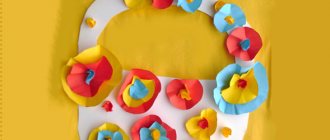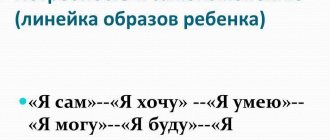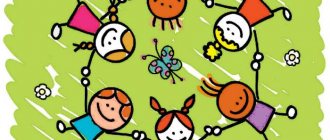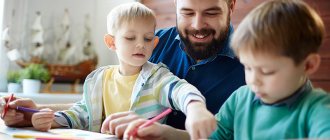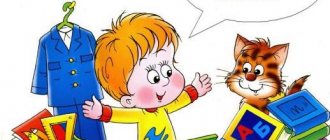The ability to count makes the life of even an adult much easier, because it allows you to be more efficient at work, save time, and achieve better results. As for children, mental arithmetic skills are needed so that they can more successfully master the exact sciences when they study at school, and also competently operate with objects in the surrounding world.
As has already become clear, you need to think about how to teach your precious child to count long before the time comes when it’s time to go to first grade. It is precisely because of the need for appropriate teaching methods and the relevance of this issue in general that not only specialists in preschool education, but also parents themselves over the years, learning from their mistakes, have come up with various ways to teach children to count.
Some methods have sunk into oblivion over time, but some people continue to use today. Let's talk about those used by modern parents and teachers.
At what age does skill appear?
From birth, children show interest in everything that surrounds them, what adults tell and show them. But not everything can be taught to them.
New material should be supplied not just in doses, but also in a certain form, as well as at a certain age. Only in this way will the child happily accept and assimilate what they want to teach him.
Teaching Mathematical Calculations
Note! Methods of teaching numeracy will differ in different age groups.
Psychologists and early childhood educators identify several age stages associated with learning to count:
- up to three years;
- 3-4 years;
- 4-5 years;
- 5-7 years.
Already at the age of two or three years, a child is able to learn to count. He understands simple ordinal counting and can show that he is going in order. For example, one candy, two candies, three apples.
From 3 to 4 years old, children are able to learn to put together small groups of objects and divide them between toys. For example, give a bear 2 candies, a doll 3 apples. And at 4 years old he can perform simple counting techniques.
After the baby masters counting to the number ten, he becomes uninterested. This usually happens by age 5. At this age, the child is able to learn numbers up to 20 and count from one to them.
Important! You can start teaching counting to 5-6 year old children at school, but it is better to do it in advance. In a light playful form at home, the child will quickly learn new information.
5-7 years is the age when a child can count to 100, add and subtract. Children happily go to the store with their parents and are able to verbally count how many coins they need to give to the seller to buy ice cream.
Three-year-old child counts on his fingers
Where to start
To start teaching your child to count, you don’t need to set aside time and wait for the right opportunity. At the first stages, mathematics (intermediate group) is suitable - counting within 5.
Showing numbers, talking about numbers, the number of objects and why they are needed should be done in a playful way that is easy and accessible to a small child. For example:
- It is worth asking to show the dogs on the street and voice this number, and then count together.
- You can count the molds that were brought into the sandbox.
- It is useful to purchase special cards for kids, which depict animals and a number that indicates their number.
Games for the development and education of preschool children
Note! You can come up with simple examples yourself and include them in games and activities. This way, the child will quietly learn the simplest mathematical operations and recognize numbers from one to five, and then beyond.
Cut out numbers
How to teach
The first thing you should teach your child is to count within 5 (middle group). You can start this activity as early as 2 years old. A child at this age happily perceives any information in a playful way and easily assimilates it if he is interested.
For learning to count from 1 to 5, fingertips, bright toys and any other material are suitable: abacus, candy, cards with images of animals.
Important! At the first stages of learning to count (from 1 to 5), you should not show your child numbers and teach him to write them.
There is no need to force tasks on your child; it is better not to overdo it, and then he will happily count everything around.
Animal cards
Learning to count to 10
As soon as the child understands what it is to count to 5, you can move on to learning to count to the first ten.
Note! Kids like large, beautiful drawings, so you can offer him special mnemonic cards that will depict objects of the living and inanimate world and numbers indicating their quantity. This way the child will become familiar with numbers.
To develop counting skills, you can come up with many interesting exercises:
- count together everything that is visible on a walk, in the store and at home;
- watch educational short cartoons;
- listen to counting songs;
- take advice from books on child development (Montessori).
Gradually, the child will learn to count from 1 to 10, will be able to add and subtract within these numbers, will name the reverse order (from 10 to 1), and then you can move on to the next stage: learning to count to 20 and to 100.
From 10 to 100
Counting up to 100, and then further (multiplying, dividing, doing this in a column) children study at school from 1st to 3rd grade. But you can get ahead of yourself a little and introduce your child to dozens at home.
Counting from 10 to 100 is available from the age of 5 years. Just like before this age, training should be simple, but regular. And at this stage it is no longer possible to do without serious explanations and completing tasks:
- It is worth telling your child what the composition of a number is, what each ten consists of, and showing this using objects. The first digit is ten, the second shows units.
- It is advisable to tell how to count from 10 to 20 and beyond.
- It is recommended to learn counting from 10 to 20.
When the child understands the principle of counting from 20 to 30, all exercises can be done by counting to 100. It is worth accustoming the child to daily small “lessons”, asking him to repeat what was told to him, and he will very soon learn the material.
Examples of pedagogical technologies in preschool education
Important! Children do not like it when their parents give them tests and exams. You can find a form of teaching and testing knowledge that will be enjoyable for the child, including him in a game, for example.
Quick techniques
Methodology of Sergei Polyakov
It takes the integrity of children’s thinking as a basis, while along with visual memory, motor memory is also activated.
A series of exercises is presented with cubes on which numbers are shown. Kids learn the quantitative characteristics of objects without counting them.
Mastery begins with the ability to count to 10. Then there is an addition not by one, but by 3, 5, 6, etc. This is how children develop an understanding of “more” and “less” on an intuitive level.
The technique is aimed at the fact that the toddler begins to remember the number on the cubes, which is based on the number of similar objects.
The method helps the child recognize the quantitative composition of objects without counting them.
The most important thing is that classes can be held in any place where at least some variety of subjects is presented. The big advantage of the method is that classes are conducted in the form of a game for 15-20 minutes.
Peterson technique
Based on the “layer cake” structure. Its essence is that during the learning process, the material being studied is layered on top of existing material, like in a layer cake.
The age characteristics of the children are taken into account. Classes begin at the age of three in a game format.
The peculiarity of the method is that the child obtains knowledge on his own and learns to solve tasks and problems in his own ways, so the knowledge becomes deeper.
The important thing is that it is possible to conduct classes at home with the help of books and teaching aids for each age.
Training according to Zaitsev
Developmental activities begin at the age of three. It is based on a set of developed schemes, which represent numbers from 0 to 9.
The first scheme makes it possible to quickly do mathematical operations in your head within a hundred.
The following table makes it possible to master three-digit numbers and their composition: hundreds, tens, thousand.
The third is given for the purpose of manipulating multi-digit numbers.
The essence of this technique is to show the relationship between various functions of numbers based on the completion of training tasks.
The author is confident that when they complete tasks, they quickly master arithmetic operations with numbers within a hundred.
Mental counting without fingers
They begin to introduce the child to counting, using for this what is always at hand - his and the parent's fingers. Gradually complicating the tasks, they move on to counting the objects around them, and after getting acquainted with tens and hundreds, they no longer have enough fingers.
Learning to count without using your fingers will take time and practice.
Counting on fingers
Why teach children mental calculations?
Today, when you have a phone with a calculator at hand, mental counting seems like a relic of the past, and it’s difficult to explain to a child why he needs to learn to count in his head.
If such a problem arises, you can give several examples and tell your child how important it is to be able to count in his head and find the correct answer without using electronics. For example:
- what to do if you need to calculate how much change they will give in a store;
- what to do if you don’t have a calculator at hand - don’t ask strangers to do the math for yourself;
- how to check if you were cheated when you gave change for a large amount of money;
- how to find out if you have enough money for all your purchases.
Note! There are many examples. You can say that mental arithmetic develops memory, and this is important at any age and in any activity.
Useful tips
In conclusion, here are some useful tips that will help you quickly learn mental arithmetic:
- Don't forget to exercise every day;
- do not quit training if the results do not come as quickly as you would like;
- download a mobile application for mental calculation: this way you don’t have to come up with examples for yourself;
- Read books on fast mental counting techniques. There are different mental counting techniques, and you can master the one that best suits you.
The benefits of mental counting are undeniable. Practice and every day you will count faster and faster. And if you need help in solving more complex and multi-level problems, contact student service specialists for quick and qualified help!
Quick mental arithmetic: learning for children
Having taught their child to use addition and subtraction on their fingers, parents wonder how to teach their child to count in his head, and do not always find the answer.
Note! There are several methods for teaching mental arithmetic, with which an adult can explain to a child what actions need to be performed to get an answer.
Each technique is an algorithm of certain actions:
- Layout of tens and units in addition, multiplication, division.
- Subtracting 7, 8, 9. For example, to subtract 9 from any number, you need to subtract 10 from this number and add 1. And do the same with 7 and 8.
- Fast addition of two-digit numbers. To do this, you need to round the digit of a two-digit number upward, perform the addition, and then subtract the number by which the increase was made. For example: 14+29=14+30-1=43.
You can teach your child to count to 100, subtract and add in the range from one to twenty, without a teacher and before school. Such an action as quick mental arithmetic is more difficult for children and does not come right away. Learning for children is, first of all, a game, so you should not rush, but rather be patient, and everything will work out.
General recommendations
Before you start learning, check if your child is ready.
Developing thinking
Mental arithmetic requires developed abstract thinking, which allows a person to understand various concepts and work with abstract images and concepts.
The problem is that in 5-7 year old children it is just beginning to develop. This is a labor-intensive process: teenagers and even young adults continue to develop abstract logical thinking over time.
Therefore, it is necessary to use visual-figurative thinking based on specific visual images - this will make it easier for the child to understand what is required of him:
- use counting sticks, magnets and pictures to learn math;
- ask to see the numbers you name - let this become a daily exercise;
- connect them with concepts already familiar to the baby (3 heroes, 5 fingers, 7 gnomes);
- together draw objects by which you can remember the numbers (8 legs for a spider, 4 for a cat);
- ask what numbers are near you right now - signs, price tags, numbers;
- use them more often in speech: “You are 5 years old now, next year you will be 6. How old is Masha?”
Basics of arithmetic
First of all, make sure that your baby can count to 10 and back freely, otherwise further exercises will be difficult. Then you can master basic arithmetic operations.
Tell and show what the composition of a number is: it turns out that 4 apples are both 3+1 and 2+2. Place them on the table and demonstrate each example in detail.
Gradually you can move on to subtraction and multiplication. Children should know the concepts of “more”, “less”, “equally” and understand why they are needed.
The main rules that will simplify classes:
- math is just a game, don’t turn your studies into a long lecture about numbers;
- make the explanation as clear as possible;
- praise for the slightest successes;
- counting in your head should become commonplace - count trees while walking, pencils in your pencil case, cars on the road;
- Regularity and repetition of material are the basis of strong knowledge.
